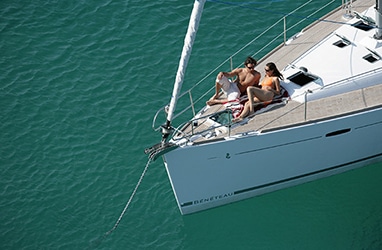
This article is an excerpt from NauticEd’s Bareboat Charter Course, a comprehensive online course that equips you with all the necessary skills and knowledge to successfully charter a yacht. The Bareboat Charter course is part of the Bareboat Charter Master bundle of online courses, fully preparing you for near-coastal sailing and sailing charters.
You can learn to sail and improve your sailing with NauticEd, the international leader in sailing education.
Typical Sailboat Energy Usage
Here we show the devices and how much energy you would typically use on a sailing boat on a sailing vacation each day.
|
Device |
Calculation |
watt-hrs |
|
Navigation equipment |
10 watts for 10 hours |
100 watt.hrs |
|
Autopilot |
80 watts for 6 hours |
480 watt.hrs |
|
VHF (in standby) |
3.6 watts for 8 hours |
30 watt.hrs |
|
Radar |
40 watts for 6 hours per day |
240 watt.hrs |
|
Lights |
5 @ 7 watts for 5 hours |
175 watt.hrs |
|
Anchor light |
10 watts 12 hours |
120 watt.hrs |
|
Fans |
4@10 hrs |
150 watt.hrs |
|
Fridge and freezer |
50% duty cycle |
720 watt.hrs |
|
Bow thruster |
4800 watts for 1 minute/day |
80 watt.hrs |
|
Electric Windlass |
1600 watts for 2 minute/day |
50 watt.hrs |
|
Electric Winches |
1200 watts for 10 minutes per day |
200 watt.hrs |
|
USB charging station |
5 devices at 5v and 1 amp 12 hours/day |
60 watt.hrs |
|
Microwave |
1200 watts for 10 minutes / day |
20 watt.hrs |
|
Electric toilets |
200 watts 12 flushes 20 seconds each |
12 watt.hrs |
|
Fresh water pump |
72 watts for 20 minutes/day |
25 watt.hrs |
|
Bilge pumps |
hopefully zero |
|
|
LP Gas Solenoid |
7.2 watts for 5 hours |
36 watt.hrs |
|
Entertainment systems |
100 watts for 8 hours |
800 watt.hrs |
|
Water Maker |
1100 watts for 1 hour |
1100 watt.hrs |
|
Inverter 12v dc to 110v(220v) ac* |
110 watts * |
* |
|
Total |
|
4400 watt-hrs |
* The inverter drainage is left out of the total since many boats do not have one. However, note that it is a large drain of power. It is called a parasitic drain because even when the inverter is not being used it is still draining that amount of power. Make sure you switch off the inverter when you are done using it. Left on for 24 hours, the amount of energy for nothing is 110 x 24 = 2.5kW.hrs. Meaning it will run your whole house system almost empty. BIG NOTE: turn off the inverter unless it is powering something essential.
With the typical house battery capacity of about 1500 watt.hrs, the above table means that 2 big batteries could not supply the energy you use in one day. Your fridge would shut down and your very annoying low-voltage alarm would turn on (if there is one).
What all of this really means is that as the manager of the boat, you must monitor very closely your energy usage, be cognizant of its depletion rate, and properly plan to top up your batteries with energy from available sources throughout the day.
You can learn more in the Bareboat Charter Online Course....
The Bareboat Charter online sailing course is your go-to resource for planning an unforgettable sailing vacation. This comprehensive online course equips you with all the necessary skills and knowledge to successfully charter a yacht. Upgrade to the Bareboat Charter Master bundle of courses to fully prepare for near-coastal sailing and sailing charters.
